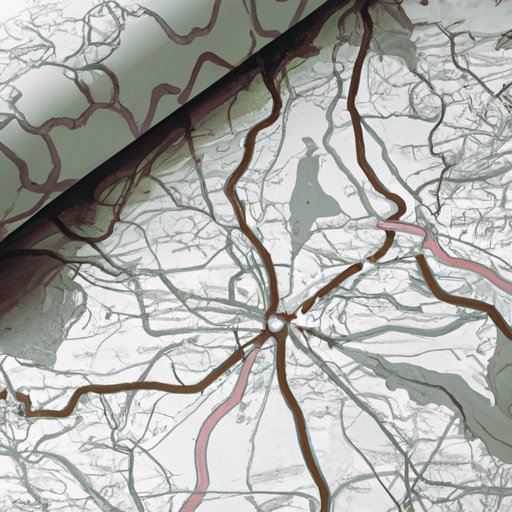I. Introduction
Maps are an essential tool for navigating the world around us. In the simplest terms, a map is a visual representation of physical space. However, they are much more than that. They allow us to plan routes, navigate unfamiliar territory, and understand our surroundings better. This article will provide a comprehensive guide to what maps are, how they have evolved over time, their importance in our lives, and how to read them.
II. A Beginner’s Guide to Cartography: Understanding Maps and Their Functions
Cartography is the art and science of mapmaking. Maps can be used for a variety of purposes, from understanding geographic features to visualizing data. They can be classified into different types, including physical, political, topographic, and thematic. Physical maps show natural features like mountains, rivers, and oceans. Political maps provide information on man-made boundaries such as cities, states, and countries. Topographic maps display detailed information about the terrain. Thematic maps visualize specific data, such as population density, weather patterns, and demographic information.
Maps contain essential features such as scales, symbols, and legends that help us understand the information presented. The scale of a map refers to the relationship between the size of a representation on the map and its actual size in the real world. Symbols represent different landmarks, features, or phenomena. Legends are explanations of what the symbols on a map mean.
III. The Evolution of Mapping: From Ancient Times to Modern Technology
Maps have been around for thousands of years, dating back to ancient civilizations. The earliest known maps are from Babylonian and Egyptian societies. These maps were mainly used for religious and bureaucratic purposes, such as identifying the boundaries of land or promoting the power of the ruling monarch.
In the Middle Ages, cartographic techniques such as compasses, celestial observation, and map projections were developed, resulting in more accurate maps. Later in the 15th century, the invention of printing led to the mass production of maps. The 20th century saw the rise of aerial and satellite imaging technologies that revolutionized the accuracy and production of maps.
IV. Why a Map is More Than Just a Piece of Paper: The Importance of Mapping in Our Lives
Maps play a crucial role in our daily lives. They are fundamental to navigation, planning and development, emergency response, and urbanization. Without maps, we would struggle to understand the world around us or communicate and organize information about it. Throughout history, maps have helped shape, record, and visualize human experiences and interactions with the natural world.
Maps have played a critical role in many historical events. For instance, the United States’ Lewis and Clark expedition in the early 19th century created accurate maps, which facilitated successful negotiation for land treaties with Native American tribes and exploration of other parts of the continent.
V. Lost and Found: How Map Reading Skills Can Help You Navigate the World
Map reading skills are fundamental for navigation and orientation. Knowing how to read a map is essential for hikers, outdoor enthusiasts, and travelers. Even with advanced mapping technologies like GPS, traditional map-reading skills are still relevant. One practical tip is to always orient the map to the direction you are facing. This simple technique can help you find your location, plan your route, and avoid getting lost.
Developing map reading skills has many benefits beyond just navigation. It can enhance spatial awareness and improve critical thinking and problem-solving skills. Map reading skills could be helpful in many careers, from urban planning to environmental science, where spatial analysis and interpretation are required.
VI. Mapping Our World: An Exploration of How Maps Represent Reality
Maps are representations of reality, but the relationship between the two is not always straightforward. Map projections, scale, and the generalization of features can cause distortions. The nature of mapping means that certain elements are always prioritized over others. Therefore, it is important to be aware of how these choices are made and how they shape our understanding of the world.
Maps have been used in many different contexts to represent reality. For instance, historical maps that show the declining level of the Aral Sea in Uzbekistan, provide evidence for the devastating effects of water mismanagement in Central Asia. They can also be used to track the spread of diseases such as COVID-19.
VII. Beyond the Borders: How Maps Shape and Reflect Cultural and Political Realities
Maps also play a significant role in shaping cultural and political ideologies. They can be used to reinforce existing power structures, to depict certain groups as superior or inferior, or to erasure certain groups entirely. There have been many instances where maps have been used to promote colonialism or to legitimize invasions. Making decisions on map design and content can be complex and involves many ethical considerations.
However, mapping can also be a tool for social change and activism. Maps created by marginalized groups can challenge dominant perspectives and give voice to different communities and worldviews.
VIII. Conclusion
Maps are more than simple representations of physical space. They are critical tools for understanding the world and our place in it. Maps help us navigate, plan, and develop, and have played a significant role in historical events. Being able to read and interpret maps is a crucial life skill. However, it is important to recognize that maps are not neutral and that they can reflect cultural and political realities that have real-world consequences.
Understanding maps, their functions, and their impact on our world is essential. By doing so, we can unlock their full potential for education, enlightenment, and social change.
